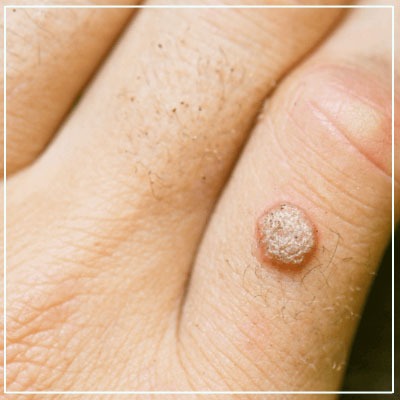Wart Removal Treatment
Warts
Warts are small growths that are caused on the skin due to a virus from the human papillomavirus (HPV) family. The virus causes these non-cancerous growths by causing additional skin cell growth, which causes the skin in that area to become hard and thick.
Everyone who comes into contact with the virus is not affected. People with skin diseases such as eczema or who have had a skin injury are highly susceptible to the virus. Children and teenagers are also at a higher risk of developing warts since their immune systems are not as developed as adults’.
Warts are also highly contagious. So a direct skin contact or using objects like razors or towels of a person suffering from the skin ailment may lead to contracting the disease yourself.

Types Of Warts:
Common warts: Common warts are small in size and are hard and bumpy. These flesh coloured bumps with rounded tops usually grow on your toes and fingers.
Flat Warts: Flat warts are most commonly found on the face, legs, and arms. They are flat and brownish, pinkish, or somewhat yellowish in color . And even though they are small in size, they appear in large numbers.
Plantar Warts: Often mistaken with calluses, Plantar Warts grow on the soles of your feet. These warts can make walking difficult because they leave a lingering sensation of a stone caught in the shoe. They have a black dot on their surface and are flat and thick. There might be either a single wart or a cluster of them.
Filiform Warts: Filiform warts have a skin-colored appearance and appear around the nose, eyes, and mouth.
Periungual warts: Periungual warts are painful warts that develop in the nails. They also have an impact on nail growth.
Genital Warts: These warts are spread by sexual contact with an infected person. These are small skin-colored pimples that develop in the genital region.
Treatments
Topical Applications: Salicylic acid gels, ointments, and creams have proven to be effective in the treatment of warts. It’s important to remember that you should just use the cream or gel on the wart and use petroleum jelly to preserve the healthy skin.
Cryotherapy: Liquid nitrogen is sprayed or applied to the affected area in this procedure. By freezing the cells in the wart, this treatment kills them. A blister may form, which scabs and comes off after a week or two. In two to four sessions, the results can be seen.
Electrofulguration Or Curettage Of The Lesion: After applying a topical anaesthetic cream to the affected area, radio frequency or electrocautery is utilised to remove the lesion’s desiccated surface.
Laser Surgery: A laser beam is used to burn and kill the wart. Scarring may occur as a result of this treatment.
CO2 Laser: This is a laser treatment that is used to eliminate wart cells by rapidly heating the fluid within them.
Immunotherapy: Intralesional injection of certain vaccines are given to increase the immune response of the body, which will lead to destruction of the virus.
For more information & consultation on Warts treatment, visit VIVA Aesthetic Clinic at Opera House or contact us on 022 3573 1556 | 93245 89084 or simply fill in your name and number & one of our team member will get in touch with you soon. Our team of experts along with Dr. Deepam Shah, MD. DNB. FAM – Dermatologist, Cosmetologist & Hair Transplant Surgeon, will help you out in understanding your problem and guide you through every stage of your treatment.
